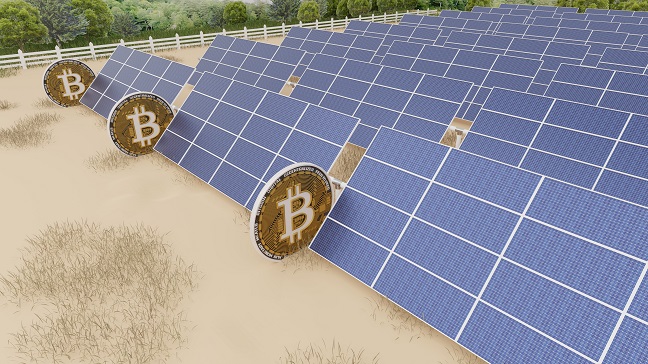The Green Hash: A Realistic Guide to Solar-Powered Crypto Mining

Cryptocurrency mining and environmental sustainability have long been at odds. The immense computational power required to secure blockchain networks, particularly for Proof-of-Work coins like Bitcoin, translates into massive electricity consumption, often generated from fossil fuels. This has led to a significant environmental debate surrounding the digital assets industry. But what if there was a way to participate in this digital frontier while completely sidestepping the grid?
Welcome to the ambitious and innovative world of solar-powered crypto mining. This concept involves creating a self-sufficient, off-grid mining operation fueled entirely by the sun. It’s a vision that promises to turn the energy-intensive process of mining into a green, sustainable endeavor. While the idea is compelling, the reality is a complex balancing act of technical knowledge, economic viability, and geographical luck. This guide will provide a realistic, no-nonsense look at what it truly takes to build a solar mining rig from the ground up.
The Core Challenge: The Energy Equation
Before diving into hardware, it’s crucial to understand the fundamental challenge: cryptocurrency mining is incredibly energy-hungry and demands consistent, 24/7 power. Solar power, by its very nature, is intermittent. It’s only generated during daylight hours and is affected by weather, season, and location.
Therefore, a solar mining setup is not just about solar panels and a mining rig. It’s a complete energy ecosystem designed to do two things:
- Power the mining rig during peak sunlight hours.
- Store enough excess energy to keep the rig running through the entire night and on cloudy days.
This storage requirement is the single biggest hurdle and the primary driver of cost and complexity.
Part 1: The Power System – Your Off-Grid Foundation
Building the power system is the most critical and expensive part of the project. It consists of four key components.
1. Solar Panels (The Engine)
This is where your energy generation begins. You need to calculate your required solar array size based on your mining hardware’s consumption and your location’s average “sun-hours” per day.
- Calculation Example: Let’s say you want to run a modest 500-watt mining rig 24/7.
- Daily energy consumption: 500 watts * 24 hours = 12,000 watt-hours (Wh) or 12 kWh.
- Let’s assume your location gets an average of 4 peak sun-hours per day.
- You’ll need a solar array of at least: 12,000 Wh / 4 hours = 3,000 watts (3 kW).
- This would mean acquiring ten 300-watt solar panels or a similar configuration.
2. The Battery Bank (The Fuel Tank)
This is where you store the energy needed to survive the night. It is the most expensive component of the entire system.
- Battery Type: Lithium-ion batteries (specifically LiFePO4 – Lithium Iron Phosphate) are the modern standard. They are safer, last much longer (more charge cycles), and are more efficient than traditional lead-acid batteries.
- Sizing the Bank: You need to store enough energy for the ~14-16 hours of darkness, plus a buffer for cloudy days.
- Nightly consumption: 500 watts * 16 hours = 8,000 Wh (8 kWh).
- To be safe, you’d want at least a 10-12 kWh battery bank. This allows for some inefficiency and a small buffer. As you can see, the battery capacity needs to be almost as large as your total daily consumption.
3. The Charge Controller (The Brain)
This device sits between your solar panels and your battery bank. Its job is to regulate the voltage and current coming from the panels to prevent overcharging and damaging your expensive batteries. An MPPT (Maximum Power Point Tracking) charge controller is essential for maximizing the energy harvested from your panels.
4. The Inverter (The Translator)
Your solar panels and batteries operate on DC (Direct Current) power. Your mining rig’s power supply unit (PSU) runs on AC (Alternating Current). The inverter’s job is to convert the DC power from your batteries into usable AC power for your rig. You need a pure sine wave inverter to provide clean, stable power that won’t damage sensitive electronics. Its wattage rating must be higher than your rig’s total power draw (e.g., a 1000W inverter for a 500W rig).
Part 2: The Mining Hardware – Efficiency is Everything
In a grid-powered setup, miners often focus purely on raw hash rate. In a solar-powered crypto mining setup, the most important metric is hash rate per watt (H/W). You need the most computationally efficient hardware possible to minimize your energy footprint.
Option 1: ASIC Miners (Application-Specific Integrated Circuit)
- Pros: ASICs are designed to do one thing and one thing only: mine a specific algorithm (e.g., SHA-256 for Bitcoin). They offer the highest possible hash rate for their energy consumption. A modern ASIC is far more efficient than a GPU for mining Bitcoin.
- Cons: They are expensive, loud, generate a lot of heat, and can become obsolete if the coin’s price drops or the network’s difficulty increases.
- Best for: Someone serious about mining a specific, major coin like Bitcoin.
Option 2: GPU Mining Rigs (Graphics Processing Unit)
- Pros: A rig built with multiple GPUs is more versatile. You can switch between mining different cryptocurrencies (altcoins) depending on which is most profitable. The components (GPUs, motherboards) can also be resold to gamers or creators if you decide to stop mining.
- Cons: They are generally less energy-efficient for a given hash rate compared to a modern ASIC.
- Best for: Hobbyists and those who want flexibility to mine various altcoins.
The Golden Rule of Hardware Selection: Research the power draw (in watts) of any mining hardware before you buy it. This number will be the foundation for designing your entire solar power system.
The Economic Reality: Is It Profitable?
This is the multi-thousand-dollar question. The profitability of solar-powered crypto mining is a razor-thin calculation that depends on several fluctuating variables:
- High Upfront Cost (CapEx): Your biggest barrier is the initial investment. A robust solar and battery system capable of running a single, modern ASIC 24/7 can easily cost $10,000 – $20,000 or more.
- Cryptocurrency Prices: The value of the coin you are mining is highly volatile. A setup that is profitable when Bitcoin is at $70,000 could be losing money (relative to the hardware cost) if the price drops to $30,000.
- Network Difficulty: As more miners join the network, the “difficulty” of finding a block increases. This means your hardware will earn less and less of the same coin over time.
- The “Opportunity Cost” of Solar: Could you get a better return on your investment by simply using your solar system to power your home and reduce your electricity bills (a guaranteed return) rather than speculating on crypto mining?
For most people, at current hardware and battery prices, achieving a quick ROI on a solar-powered crypto mining operation is extremely difficult. It is more of a long-term passion project for those who are deeply committed to both renewable energy and the cryptocurrency ethos.
The Future: A Greener Horizon?
Despite the challenges, the future of sustainable mining is bright. Several factors could make this practice more viable over time:
- Decreasing Battery Costs: As battery technology improves and manufacturing scales up (driven by the electric vehicle industry), the cost of energy storage is expected to fall significantly.
- More Efficient Mining Hardware: The relentless competition among hardware manufacturers continues to produce more energy-efficient chips.
- The Rise of Proof-of-Stake (PoS): Many cryptocurrencies are moving away from energy-intensive Proof-of-Work mining to Proof-of-Stake, a consensus mechanism that requires vastly less energy. Ethereum’s successful “Merge” is the most prominent example.
Conclusion: A Project of Passion, Not Just Profit
Building a solar-powered crypto mining rig is one of the most challenging and rewarding projects an enthusiast can undertake. It sits at the nexus of electrical engineering, financial technology, and environmental consciousness. However, it should be approached with a clear head and realistic expectations.
This is not a get-rich-quick scheme. The upfront costs are substantial, and profitability is far from guaranteed. Instead, view it as a powerful educational experience and a statement of principle. You are learning to be your own power company, participating in securing a global financial network, and doing it all with clean, silent, and sustainable energy. For the dedicated builder, that achievement itself is the ultimate reward.




